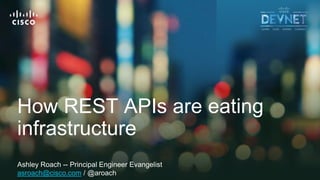
How REST APIs Drive Infrastructure Automation
- 1. 1© 2018 Cisco and/or its affiliates. All rights reserved. Cisco Public How REST APIs are eating infrastructure Ashley Roach -- Principal Engineer Evangelist asroach@cisco.com / @aroach
- 2. 2© 2018 Cisco and/or its affiliates. All rights reserved. Cisco Public REST APIs are “eating” infrastructure
- 3. 3© 2018 Cisco and/or its affiliates. All rights reserved. Cisco Public Software is eating the world Marc Andreesen, 2011
- 7. ?
- 8. 8© 2018 Cisco and/or its affiliates. All rights reserved. Cisco Public ● DevOps and SRE are now accustomed to automating infrastructure ● Automation is driven by APIs ● Rise of powerful scripting languages (Python, JavaScript/Node) ● REST APIs are pervasive REST API Market Drivers
- 9. 9© 2018 Cisco and/or its affiliates. All rights reserved. Cisco Public “Infrastructure as Code”
- 10. 10© 2018 Cisco and/or its affiliates. All rights reserved. Cisco Public Terraform configuring Data Center Infrastructure Spin-up/Config ● Definition of infrastructure (AWS, OpenStack, etc) via declarative code
- 11. 11© 2018 Cisco and/or its affiliates. All rights reserved. Cisco Public Ansible ● Configuration management and deployment ● E.g. install/config MongoDB in VM
- 12. 12© 2018 Cisco and/or its affiliates. All rights reserved. Cisco Public CI/CD Driving Changes to Network
- 13. 14© 2018 Cisco and/or its affiliates. All rights reserved. Cisco Public Lots of infrastructure APIs
- 14. 15© 2018 Cisco and/or its affiliates. All rights reserved. Cisco Public http://cs.co/cisco-postman-collections
- 15. 16© 2018 Cisco and/or its affiliates. All rights reserved. Cisco Public REST APIs are eating infrastructure
Editor's Notes
- Did you know that REST APIs are “eating” infrastructure?
- You probably have heard Mark Andreesen’s thesis that “software is eating the world”. What does this mean? Current environment of software, hardware, cloud computing, and so on has created a perfect environment for software innovation.
- We’ve seen Uber impact taxi services
- Amazon impacting retail booksellers at first, and more now
- Napster ushered in the “streaming” world
- Now all of these are “disruption” examples. While there is a dynamic of software impacting infrastructure, this doesn’t mean that no hardware will exist. Serverless! What inspired me in what Andreesen meant is his claim that the power of hardware enables the growth of software. Because of extra compute, new features like run containers at the edge. IoT! BUT Most importantly! REST APIs can now be built on infra my thesis of REST APIs eating infrastructure…eating legacy ways of interacting with infrastructure NOT replacing infrastructure No longer going sequentially SSHing from box to box No longer fragile methods like SSH or manually Look at the market
- Thanks to DevOps and SRE practitioners, automating infra has come to the forefront. Much of that automation is driven by software and corresponding REST APIs – they’re like the lingua franca of automation these days. AND powerful scripting languages makes calling REST APIs EASY! When we started DevNet 4 years ago, people thought that APIs might be a fad for infrastructure – but here we are, and there’s only uptick in the consumption of REST APIs.
- All of this boils down to the concept of “infrastructure as code”... let’s look at some examples
- Terraform! Defines infrastructure via declarative code
- Ansible! Configuration management and deployment through code
- Now, REST APIs on infrastructure enable a DevOps or SRE team to implement CICD at layers beyond the application. NETDEVOPS configure, test, and deploy changes to the network
- REST APIs into DNS -- provide insight into malicious domains discovered during analysis. Block users from connecting to the known malicious domains, preventing data exfiltration.
- And yet more examples! Kubernetes Master Node API Server -- api to your infrastructure Docker’s success is partly due to ease of use and a nice REST API -- api to compute Cisco’s infra aggregated into a controller enabled by the RESTCONF standard for devices -- new architectures controllers api layer and device layer All enabled by REST APIs
- Since we’re at POST-CON, we use Postman extensively to help our customers understand this new landscape of infrastructure REST APIs. (Meraki, APIC-EM) Find them at developer.cisco.com
- Riffing off of Andreesen’s metaphor How I see…is REST APIs ARE eating infrastructure by enabling engineers to 1) stop interacting manually with infra 2) use automation instead of fragile interfaces like SSH This enables us build solutions faster with more reliability. Do you have examples of REST APIs eating infra?
